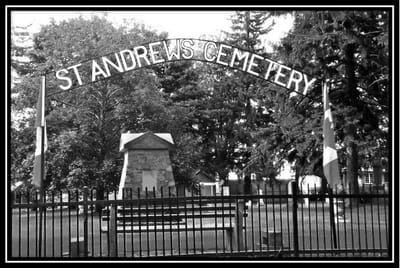
HISTORY
The property for St Andrew's Cemetery was acquired in 1845 from John Finkle who was the village miller. The site consisted of 1.618 acres of land and the purchase price was recorded at "five shillings". At that time a small (36' x 47') wooden framed church was constructed by the local residents.
The church opened for services in 1847 but it was not until 1855 that a regular pastor was called. Reverend Neil Bethune was the first minister, preaching only one year. He died of smallpox and was buried in the cemetery. His widow and two children returned to Scotland.
A larger brick church was erected in 1875. A commemorative cairn is now on the site of St. Andrew's Presbyterian Church. The earliest burial record is that of Hector McKay (1841-1847).
The earliest tombstones were of white stone or marble and each grave gives the information of birth, death dates and place of origin. Markings on the gravestones include the early Christian symbol of fish, willow trees, open gate, clasped hands and on the children's stones, a lamb. As the area became more prosperous, massive tombstones began to appear, often bearing the epitaphs for the entire family. Many of the stones have the Masonic or Oddfellow insignias.
MacKay, Hogg and Weir were three original pioneer families. Many of the other well-known local families can trace their roots back to the pioneers who are interred in the cemetery - Oliver, McGee, Golding, Matheson, Hutchison, Sutherland, and more.
The church opened for services in 1847 but it was not until 1855 that a regular pastor was called. Reverend Neil Bethune was the first minister, preaching only one year. He died of smallpox and was buried in the cemetery. His widow and two children returned to Scotland.
A larger brick church was erected in 1875. A commemorative cairn is now on the site of St. Andrew's Presbyterian Church. The earliest burial record is that of Hector McKay (1841-1847).
The earliest tombstones were of white stone or marble and each grave gives the information of birth, death dates and place of origin. Markings on the gravestones include the early Christian symbol of fish, willow trees, open gate, clasped hands and on the children's stones, a lamb. As the area became more prosperous, massive tombstones began to appear, often bearing the epitaphs for the entire family. Many of the stones have the Masonic or Oddfellow insignias.
MacKay, Hogg and Weir were three original pioneer families. Many of the other well-known local families can trace their roots back to the pioneers who are interred in the cemetery - Oliver, McGee, Golding, Matheson, Hutchison, Sutherland, and more.